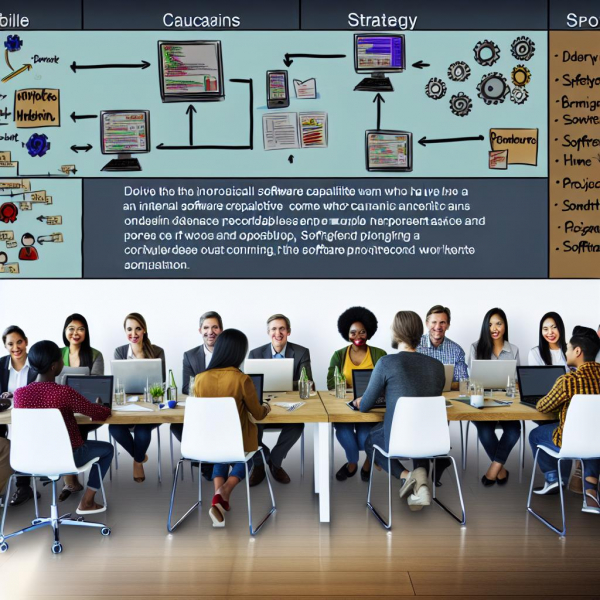In the digital age, where software is the beating heart of most businesses, developing an internal software capability can be a game-changer. It’s like having a secret weapon, a magic wand that can transform your business operations, streamline processes, and catapult your organization into the future. But how do you go about creating this powerful tool? Fear not, for we have charted the course for you. In this article, we will unveil six insightful tips that will guide you in building a robust internal software capability. So, buckle up and prepare for a journey into the fascinating world of software development.
Table of Contents
- Understanding the Importance of Internal Software Capability
- Building a Strong Foundation: Essential Skills and Tools
- Investing in the Right Talent: Hiring and Training Strategies
- Creating a Collaborative Environment for Software Development
- Implementing Agile Methodologies for Better Results
- Leveraging Automation and AI in Software Development
- Measuring Success: Key Performance Indicators and Metrics
- Q&A
- To Conclude

Understanding the Importance of Internal Software Capability
In today’s digital age, having an internal software capability is no longer a luxury but a necessity. It’s a strategic asset that can significantly enhance your business operations, improve efficiency, and give you a competitive edge. However, building this capability requires a strategic approach, careful planning, and the right resources. Here are six tips to help you create an effective internal software capability.
Firstly, identify your business needs. This involves understanding your business processes, identifying areas that can be improved with software, and defining your software requirements. Secondly, invest in the right talent. You need a team of skilled software developers who can design, develop, and maintain your software. Thirdly, adopt agile methodologies. Agile methodologies promote continuous improvement, flexibility, and customer satisfaction.
| Tip | Description |
| Identify your business needs | Understand your business processes and identify areas that can be improved with software |
| Invest in the right talent | Build a team of skilled software developers |
| Adopt agile methodologies | Promote continuous improvement, flexibility, and customer satisfaction |
The fourth tip is to establish clear communication channels. This ensures that everyone involved in the software development process is on the same page and can collaborate effectively. Fifthly, implement robust testing procedures. This helps to ensure the quality of your software and minimize the risk of bugs and errors. Finally, continuously improve and update your software. This helps to keep your software relevant and effective in meeting your business needs.
| Tip | Description |
| Establish clear communication channels | Ensure effective collaboration in the software development process |
| Implement robust testing procedures | Ensure the quality of your software and minimize the risk of bugs and errors |
| Continuously improve and update your software | Keep your software relevant and effective in meeting your business needs |
By following these tips, you can build a strong internal software capability that can drive your business forward. Remember, the key to success is to align your software capability with your business strategy, and to continuously adapt and improve as your business needs evolve.

Building a Strong Foundation: Essential Skills and Tools
Building a strong foundation for your internal software capability requires a blend of essential skills and tools. It’s not just about having the right software or the most advanced technology, but also about having a team with the right skills and knowledge to use these tools effectively.
Here are six tips to help you create a robust internal software capability:
- Invest in Training: Ensure your team is well-versed in the software tools you use. This could involve formal training courses, online tutorials, or hands-on workshops.
- Choose the Right Tools: Not all software tools are created equal. Choose ones that align with your business needs and are user-friendly.
- Encourage Collaboration: Foster a culture of collaboration and knowledge sharing. This can lead to innovative solutions and improved efficiency.
- Stay Updated: The world of software is always evolving. Stay updated with the latest trends and technologies to maintain a competitive edge.
- Implement Best Practices: Develop and follow a set of best practices for software development and usage. This can help prevent errors and improve productivity.
- Measure Success: Regularly evaluate your software capability to identify areas of improvement. Use metrics that align with your business goals.
Let’s take a closer look at the importance of choosing the right tools. The table below compares three popular project management tools: Asana, Trello, and Jira.
| Tool | Best For | Key Features |
|---|---|---|
| Asana | General project management | Task tracking, project timelines, team collaboration |
| Trello | Agile project management | Board-based task management, integration with other tools, mobile app |
| Jira | Software development projects | Issue tracking, agile reporting, customizable workflows |
Remember, the right tool will depend on your specific needs and the nature of your projects. It’s crucial to do your research and choose wisely.

Investing in the Right Talent: Hiring and Training Strategies
Building an internal software capability is a strategic move that can significantly enhance your business operations. However, it requires careful planning and execution. Here are six tips to help you create a robust internal software capability.
1. Identify the Right Talent: Start by identifying the skills and expertise needed for your software projects. Look for candidates with a strong background in software development, problem-solving skills, and a passion for technology. 2. Invest in Training: Once you have the right team, invest in their training. This could be in the form of workshops, online courses, or on-the-job training. 3. Foster a Culture of Learning: Encourage your team to continuously learn and improve. This can be achieved by providing them with access to the latest software tools and technologies.
| Strategy | Description |
|---|---|
| 4. Implement Agile Methodologies: | Adopt agile methodologies to enhance productivity and efficiency. This approach allows for flexibility and quick adaptation to changes. |
| 5. Encourage Collaboration: | Promote a collaborative environment where team members can share ideas and learn from each other. This fosters innovation and creativity. |
| 6. Measure Success: | Establish clear metrics to measure the success of your software projects. This will help you identify areas for improvement and make informed decisions. |
Investing in the right talent and implementing effective hiring and training strategies are crucial for creating a successful internal software capability. Remember, the goal is not just to build a team, but to build a team that can deliver high-quality software solutions that meet your business needs.

Creating a Collaborative Environment for Software Development
Building an internal software capability is a strategic move that can significantly enhance your organization’s efficiency and competitiveness. However, fostering a collaborative environment for software development is not a walk in the park. It requires a well-thought-out approach that encourages teamwork, promotes open communication, and nurtures a culture of continuous learning and improvement. Here are six tips to help you create a conducive environment for software development.
1. Encourage Open Communication: Open communication is the backbone of any successful team. Encourage your team members to share their ideas, concerns, and feedback openly. This can be achieved by creating platforms for team discussions and brainstorming sessions. 2. Promote Teamwork: Software development is a team sport. Foster a culture that values teamwork and collaboration. This can be done by setting team goals, encouraging peer reviews, and recognizing team achievements. 3. Provide Continuous Learning Opportunities: The tech world is ever-evolving. Provide your team with opportunities to learn and grow. This could be in the form of training programs, workshops, or access to online learning resources.
| Tip | Action |
|---|---|
| 4. Foster a Culture of Innovation: | Encourage your team to experiment and innovate. Provide them with the necessary resources and freedom to explore new ideas and technologies. |
| 5. Recognize and Reward Effort: | Recognize and reward your team’s efforts. This not only boosts morale but also encourages them to put in their best effort. |
| 6. Use the Right Tools: | Equip your team with the right tools and technologies that can enhance their productivity and make collaboration easier. |
is a continuous process. It requires constant effort, patience, and commitment. But with the right approach, you can build a high-performing software development team that can drive your organization’s success.
Implementing Agile Methodologies for Better Results
Building an internal software capability can be a game-changer for your business. It allows you to be more flexible, responsive, and innovative. However, to truly reap the benefits, you need to adopt agile methodologies. Here are six tips to help you do just that.
1. Foster a culture of collaboration: Agile is all about teamwork. Encourage open communication and collaboration within your team. Use tools like Slack or Microsoft Teams to facilitate this.
2. Embrace change: Agile is also about being adaptable. Don’t be afraid to change your plans or strategies if they’re not working. Remember, the goal is to deliver the best product, not to stick to a rigid plan.
3. Prioritize tasks: Not all tasks are created equal. Use a tool like Jira to prioritize your tasks based on their impact and urgency.
4. Use sprints: Break your work into small, manageable chunks called sprints. This allows you to focus on one thing at a time and makes it easier to track progress.
5. Get feedback: Regularly get feedback from your users. This will help you understand what’s working and what’s not, and make necessary adjustments.
6. Continuously improve: Agile is a continuous process. Always look for ways to improve your processes and products.
| Methodology | Key Benefit |
|---|---|
| Collaboration | Enhances teamwork and communication |
| Embracing Change | Increases adaptability and flexibility |
| Prioritizing Tasks | Improves efficiency and productivity |
| Using Sprints | Facilitates focus and progress tracking |
| Getting Feedback | Helps understand user needs and preferences |
| Continuous Improvement | Ensures constant growth and development |
Implementing agile methodologies in your internal software capability can lead to better results, increased productivity, and a more satisfied team. Remember, the key to success is to be flexible, collaborative, and always open to feedback and improvement.
Leveraging Automation and AI in Software Development
Building an internal software capability can be a daunting task, but with the right approach, it can be a game-changer for your business. One of the key strategies to consider is leveraging automation and AI. This not only speeds up the development process but also reduces the risk of human error, leading to more reliable and efficient software.
Here are some tips to help you get started:
- Invest in the right tools: There are numerous automation tools and AI technologies available in the market. Choose the ones that best fit your business needs and budget. Some popular choices include Jenkins for continuous integration, Selenium for automated testing, and TensorFlow for machine learning.
- Train your team: Make sure your team is well-versed with the chosen tools and technologies. This might involve investing in training programs or hiring new talent with the required skills.
- Start small: Don’t try to automate everything at once. Start with simple tasks and gradually move to more complex ones as your team gets more comfortable with the technology.
- Monitor and improve: Continuously monitor the performance of your automated processes and make improvements as needed. This will ensure that your software remains efficient and up-to-date.
- Integrate AI: AI can be used to automate complex tasks that require human-like decision making. For example, AI can be used to automate code reviews, bug detection, and even some aspects of software design.
- Stay updated: The field of automation and AI is constantly evolving. Stay updated with the latest trends and technologies to ensure that your software capability remains competitive.
Here’s a simple table summarizing the above points:
| Tip | Description |
|---|---|
| Invest in the right tools | Choose automation tools and AI technologies that fit your needs and budget. |
| Train your team | Ensure your team is skilled in using the chosen tools and technologies. |
| Start small | Begin with automating simple tasks and gradually move to complex ones. |
| Monitor and improve | Continuously assess and enhance the performance of your automated processes. |
| Integrate AI | Use AI to automate complex tasks requiring human-like decision making. |
| Stay updated | Keep up with the latest trends and technologies in automation and AI. |
Measuring Success: Key Performance Indicators and Metrics
Building an internal software capability is not just about developing software, but also about measuring its success. This is where Key Performance Indicators (KPIs) and metrics come into play. These are quantifiable measures used to evaluate the success of an organization, employee, etc., in meeting objectives for performance.
When setting KPIs and metrics, it’s important to ensure they are SMART – Specific, Measurable, Achievable, Relevant, and Time-bound. Here are some examples of KPIs and metrics you might consider:
- Productivity: This could be measured in terms of the number of tasks completed, or the amount of code written in a certain time period.
- Quality: This could be measured by the number of bugs found in the software, or the amount of rework required.
- Efficiency: This could be measured by the time it takes to complete tasks, or the resources used.
- Customer Satisfaction: This could be measured through surveys, feedback, or reviews.
It’s also important to regularly review and update your KPIs and metrics to ensure they remain relevant and useful. This could be done through regular team meetings, or through a formal review process.
| Key Performance Indicator | Measurement |
|---|---|
| Productivity | Number of tasks completed |
| Quality | Number of bugs found |
| Efficiency | Time to complete tasks |
| Customer Satisfaction | Survey results |
Remember, the goal is not just to measure for the sake of measuring, but to use these KPIs and metrics to drive improvement and achieve your business objectives.
Q&A
Q: What is an internal software capability?
A: An internal software capability refers to a company’s ability to develop, manage, and maintain software solutions within its own organization, rather than outsourcing these tasks to external providers.
Q: Why is it important for a company to develop an internal software capability?
A: Developing an internal software capability allows a company to have greater control over its software solutions. It can lead to cost savings, increased efficiency, and the ability to tailor software to the specific needs of the business.
Q: What are some tips for creating an internal software capability?
A: Some tips include investing in the right talent, fostering a culture of continuous learning, implementing agile methodologies, focusing on user experience, maintaining a balance between speed and quality, and ensuring proper documentation of software processes.
Q: How can a company invest in the right talent for software development?
A: A company can invest in the right talent by hiring individuals with the necessary skills and experience in software development. This may involve offering competitive salaries, providing opportunities for professional development, and creating a positive work environment.
Q: What is the role of continuous learning in software development?
A: Continuous learning is crucial in software development due to the rapidly evolving nature of technology. It allows developers to stay up-to-date with the latest tools, techniques, and best practices, thereby enhancing their ability to create effective software solutions.
Q: How can agile methodologies benefit software development?
A: Agile methodologies can enhance software development by promoting flexibility, collaboration, and customer satisfaction. They allow for frequent iterations and adjustments, enabling the development team to respond effectively to changes in requirements or market conditions.
Q: Why is user experience important in software development?
A: User experience is crucial because it determines how easily and effectively users can interact with the software. A positive user experience can increase customer satisfaction, boost user engagement, and ultimately contribute to the success of the software.
Q: What does it mean to balance speed and quality in software development?
A: Balancing speed and quality means developing software as quickly as possible without compromising its performance, reliability, or usability. This requires careful planning, efficient processes, and rigorous testing.
Q: Why is documentation important in software development?
A: Documentation is important because it provides a clear record of the software’s design, functionality, and maintenance procedures. This can facilitate troubleshooting, enhance collaboration among team members, and ensure the software’s long-term sustainability.
To Conclude
In the grand tapestry of business evolution, weaving an internal software capability into your organization’s fabric is no small feat. It’s a journey that requires patience, strategy, and a keen understanding of your team’s strengths. But with these six tips in your toolkit, you’re well on your way to crafting a robust, self-reliant software development ecosystem. Remember, Rome wasn’t built in a day, and neither will your software capability. It’s a process of continuous learning, adaptation, and growth. So, take a deep breath, roll up your sleeves, and step confidently into the future of your organization. The digital landscape awaits your unique imprint.
